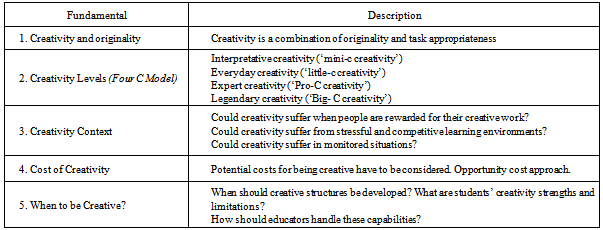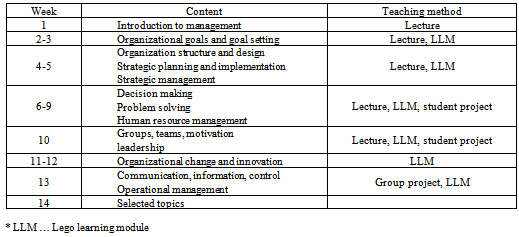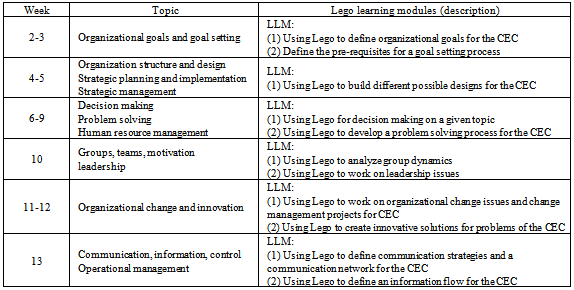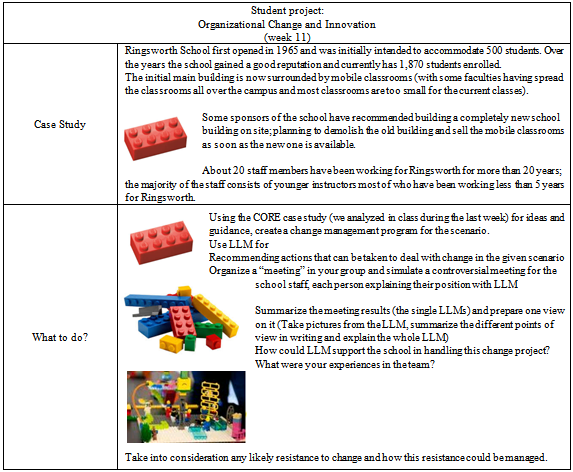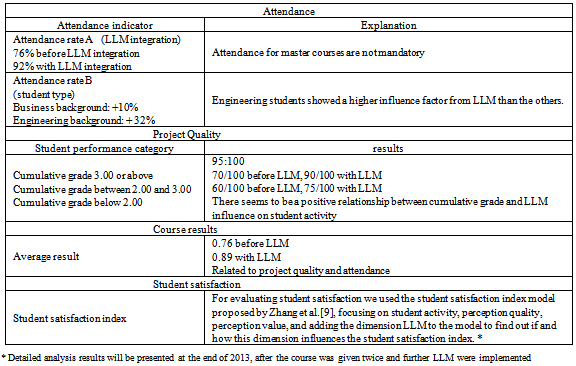-
Paper Information
- Next Paper
- Previous Paper
- Paper Submission
-
Journal Information
- About This Journal
- Editorial Board
- Current Issue
- Archive
- Author Guidelines
- Contact Us
Education
p-ISSN: 2162-9463 e-ISSN: 2162-8467
2013; 3(6): 319-324
doi:10.5923/j.edu.20130306.06
Integrating Creative Learning Elements in Higher Education Shown in the Example of a Management Information Systems (MIS) Courses
Birgit Oberer
Department of Management Information Systems, Faculty of Engineering and Natural Sciences, Kadir Has University, Istanbul, Turkey
Correspondence to: Birgit Oberer, Department of Management Information Systems, Faculty of Engineering and Natural Sciences, Kadir Has University, Istanbul, Turkey.
| Email: |  |
Copyright © 2012 Scientific & Academic Publishing. All Rights Reserved.
Creativity is a keyword in the business environment and is becoming increasingly important for education. Educators should support students in learning how to make use of their creative potential in integrating creative learning modules in course designs and the instructor-student interaction. The course concept that was designed in this study was implemented in a Turkish university in 2012, integrating elements on creative education in teaching and student learning, focusing on Lego learning modules. Considering the dimensions of quality, participation, grade, and student in order to analyze the outcome of student projects, the overall course results, and student satisfaction, the results of this ongoing study revealed that the integration of Lego learning modules (LLM) for the designed Management Information Systems (MIS) course improved the students’ performance significantly.
Keywords: Education, Creativity, Management Information System, MIS
Cite this paper: Birgit Oberer, Integrating Creative Learning Elements in Higher Education Shown in the Example of a Management Information Systems (MIS) Courses, Education, Vol. 3 No. 6, 2013, pp. 319-324. doi: 10.5923/j.edu.20130306.06.
Article Outline
1. Introduction
- Creativity is important to be successful in business life. That’s what students hear during their studies. But who is creative? How can you become creative? Can we teach creativity? Is it something measureable or countable? These are challenging questions for educators in higher education. They are increasingly pressured by society to ‘produce’ an elite group of creative entrepreneurs, innovators, and problem solvers. What we have to focus on is the language of creativity, project based learning, and breakthrough assessments. To avoid that formal education reduces creativity in the classroom in this study a sample course was equipped with creative learning elements, the Lego learning ones, to focus on creativity in higher education and the impact on students’ performance is analysed by using various dimensions to be considered.
2. Creative Education
- Universities are involved in a process of establishing and transforming structures on sustainable development in teaching, research, and cooperation focusing on the sustainability challenges of the 21st century and to be able to be competitive on global markets[11].This development let universities to develop concepts to prepare a climate for students to be creative within an interactive environment[12].Considering education and sustainability, creativity has become an important keyword in education. Being creative means achieving success in the current business environment. The main objective for educators should be preparing students for being successful in their future business life, which equals making them creative[2,3,11]. Because of this target, in recent years a discussion was started on how to integrate creative modules in students’ education. Several educators propose to integrate students’ creativity in the curricula. One challenge for university management following this creativity approach is that it is widely unclear or at least unspecified as to what creativity means and what the nature of creativity is. Beghetto and Kaufman[1] defined five fundamentals that could support educators in integrating creative learning models in students’ curricula, which are summarized in table 1.The Four C Model (2) provides a framework for including creativity modules in student curricula[1]. To work on creativity actively it is not enough to simply give students the freedom in education, follow a laissez-faire approach, and let them be; educators have to focus on teaching knowledge and skills, encourage student innovation and find a balance between a focus on creativity in curricula, teaching methods, and resources. According to Robinson[4] educators have three different dimensions for including creativity in education: (1) developing curricula, (2) teaching, (3) student learning. In this study, we focus on including creative elements in the course design and student learning, which could be included in the dimensions (2) and (3) as defined by Robinson[4].
|
3. Case Study: Creative Education Elements in an MIS Course Design
- In this study, a course on Management Information Systems (MIS), which includes creative education elements, was designed. The initial question to focus on was how creative education elements could improve knowledge retention of students. The designed course is part of a project, focusing on integrating creative education elements in higher education. The project consists of two parts, (1) the course design part, which focusing on designing courses with integrated creative learning objects, and (2) the communication structures designed for educator-student interaction. This paper focuses on (1) and shows how a sample course was designed.The goal of this research in progress was to include creative education elements in a sample course, implementing this course in higher education and evaluating student performance, before and after the implementation of the previously defined creative elements. The outcome should help educators in developing further innovative elements to be included in curricula, teaching at universities and in a student learning environment. Course management and the adaptation of curricula were not an aim of this study, which mainly focused on the educator dimension (teaching, instructor-student interaction, and student learning).Mazzarol examined the following characteristics of education: (1) the nature of education service act, (2) relationship with customers, (3) level of customization, (4) nature of demand relative to supply; and defined critical success factors for international education, focusing on resources, teaching programs and quality and expertise of staff.This analysis focuses on (2) the relationship with students, and (3) the level of customization of student’s learning modules.
3.1. Environment
- The designed course is intended for master’s degree students from the university’s social science institute, who mainly have a business administration or engineering background.There are no pre-requisites to attend the course, which focuses on MIS topics: management and organizational behavior. In the last three years, the course was given as a lecture, including no assignments, no projects that the students had to work on, and no active instructor feedback on student performance during the course; but including a midterm and final exam, mainly focusing on multiple choice questions. The student performance was sufficient (from 180 students, who attended the course within the last two years, fewer than 10 failed, 60% had a performance between BB and CC, and approx. 15% had a performance better than BB). Considering only this course, the students’ performance was sufficient, but from other courses that this MIS course was a pre-requisite of, instructors of these courses increasingly complained that there is a lack of basic knowledge about the topic, and they had to explain the basics in their courses, which means less time for the scheduled course. Considering this development, the instructor of the MIS: Management and Organizational Behavior course decided to adopt the course structure, teaching method, and course related student learning and include several creative education elements. One main aim of these activities was to engage students and other educators and provide a basis for active participation and lifelong learning.
3.2. Content
- According to CELT[6], elements of creativity could be affective, cognitive, motivational, social or environmental.Components of creativity are (1) expertise, (2) motivation, and (3) creative thinking skills. The last one focuses on how flexible and creative people address problems. Educators could foster creativity in sharing their thinking with students and explaining how to develop creative ideas [7]. The instructor focused on (2) and (3) of the CELT approach, developing a course design to motivate students and show them creative thinking approaches. The creativity element that the instructor used for creating the sample course on Management Information Systems is Lego Serious Play. In the project, different creative education elements are used, the Lego one is used for the sample course design explained in this study. Lego Serious Play uses Lego bricks as a tool to enhance innovation and business performance. Working with Lego bricks offers people a ‘language’ to communicate with each other, a problem solving tool, where everyone can contribute. Companies could use Lego bricks for strategic management, problem solving, decision making, or simply creating creative thinking. Lego serious play focuses on learning through storytelling and the use of metaphors, constructivism and constructionism, and descriptive and creative imagination[8]. Generally, for using Lego in higher education, the Lego company offers under “Lego education” opportunities to use Lego in pre-school and school; with “Lego engineering” the Center of Engineering Educational Outreach (CEEO), Tufts University, uses Lego and other tools to help students explore engineering processes, science, mathematics, and engineering. After analyzing the offers for science and engineering, the educator analyzed the needs for a business/management course including educational elements with Lego, analyzed what was offered so far from Lego for sciences and engineering, and started developing a course design for the Management Information Systems course. Table 2 shows the course design for 14 weeks. Besides for the planned content for the course, which was taken from the already existing course syllabus the teaching method(s) for each week/content was added. In addition to (1) lecture, the instructor included (2) Lego learning module (LLM), (3) student project, and (4) group project. The Lego learning modules are all included in the class activities, while group projects and student projects (1 student, 1 project) include LLM as well, but most of them were used offline; which means students work on their projects using LLM outside the classroom, but presenting their results in class to the instructor and the other students or student teams. How LLM was concretely implemented is shown in table 3.
|
|
|
|
- Generally, the students were given a case study: a sample company, the ‘Creative Element Company’ (CEC), has to be built and run (strategic and operational management), starting with general goal setting requirements (week 2-3), the design of the organization (week 4), establishing a general strategic planning process (week 5-7), planning and implementing a decision making process for the organization (week 6), developing problem solving routines and responsibilities (week 7-9), analyzing group dynamics and working on leadership issues (week 10), working on organizational change issues for the CEC (week 11), creating innovative solutions for CEC (week 12), defining communication strategies and an information flow for the CEC (week 13). A sample of the assignments that the students had to work on in groups, using LLM, is shown in table 4.
4. Analysis
- One challenge of education is to include creative elements in curricula and teaching. Educators should help students find their creative strengths in order to improve their overall performance. In this study, Lego learning modules (LLM) were integrated in a course design to motivate students and show them creative thinking approaches. The creative learning element chosen by the instructor was Lego Serious Play because (1) it uses Lego bricks as a tool to enhance innovation and business performance, (2) benefiting from the main characteristic of Lego, which is that Lego offers with its bricks a simple ‘language’ for people in an organization to communicate, simplifying thereby the need to overcome communication barriers. In this ongoing research study, the LLM elements were integrated in a sample course on MIS, which was implemented at a Turkish university in 2012. The main focus of this study is on the instructor dimension (teaching, instructor-student interaction and student learning). The first evaluation of students’ performance was done in 2013 after the course was given during the fall semester 2012. For this analysis, the instructor focused on the dimensions of quality, participation, grade, and student and evaluated project quality (based on different student performance categories), student attendance (based on the attendance indicators (1) attendance rate A[before and after the integration of creative learning objects] and (2) attendance rate B[based on different student types]), course results (based on grades and related to the dimensions project quality and attendance) and student satisfaction (based on the student satisfaction index).
5. Research Results and Discussion
- The results revealed that by focusing on LLM creative elements in teaching, students’ performance (measured in (1) outcome of students’ projects[quality dimension], (2) attendance rate[participation dimension], (3) overall course results[grade dimension], and (4) student satisfaction index[student dimension]) could be significantly improved. Detailed analysis results will be presented at the end of 2013, after the course was given twice and further LLM were implemented. In a further step, more creative elements (LLM and others) could be integrated in different courses, and course management and the needed adaptation of curricula were analyzed.
6. Conclusions
- Students are direct receivers of higher educational services; the quality of studies offered to them influences students’ satisfaction on educational quality. To motivate students, increase student perception, project quality, attendance rate, and the overall course results, creative learning elements could be used in higher education.These creative learning elements focus on different dimensions in student learning and the instructor-student interaction. In this study, Lego learning models (LLM) were developed and integrated in a sample course to measure the overall course outcome, student performance, and student satisfaction. The results revealed that there is a positive relationship between the integration of LLM and student performance. In this study, the main focus is on the instructor-student interaction and student learning. The retention of knowledge will be analysed in the following phases of this project, focusing on course management and curricula development in order to integrate creative learning elements in higher education.
 Abstract
Abstract Reference
Reference Full-Text PDF
Full-Text PDF Full-text HTML
Full-text HTML